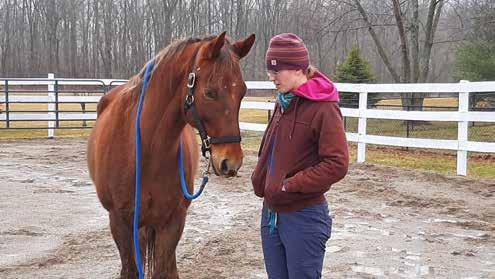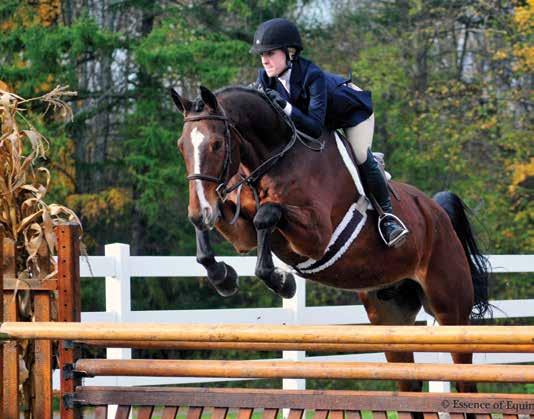
8 minute read
Resilient?
Resilient?
By Lydia Fairchok
Whoa.
The world has changed a lot in a short time. As I write this, the United States is locking down state-by-state in response to the COVID-19 pandemic that has managed to affect each and every one of us in some manner worldwide. Other countries, including Italy and Spain, are desperately trying to cope with their overwhelming caseloads. My state issued an extended shelter-in-place order three weeks ago. All non-essential businesses have been ordered to cease, travel restrictions are in place, and gatherings of ten or more persons are unlawful. Even before such mandated measures were officially implemented, teaching had already stuttered to a halt due to social distancing concerns and voluntary barn closures. Some of my students—and my own family—await news daily about friends and relatives who are being treated for COVID-19. My heart goes out to each of you who have already been affected as this unfolds, and I sincerely hope that by the time this article goes to press things are loosening up, successful treatments are underway, and the worst aspects of the pandemic are behind us.
But like it or not, certain ramifications of this event are here to stay, at least for a while. You or your loved ones may have been personally impacted by loss of friends, family or health. You have had to suspend lessons and forego competitions and the lapse of income is still being felt. Others in your supply chain of necessary goods have been affected, leading to higher costs or availability issues. Your clients are dealing with their own emotional or economic fallouts. Like every event of global magnitude, things don’t just go back to normal right away.
Resilience is a hot-button word in discussions about burnout, self-care, and mental health. Its relevance skyrockets at a time like this. The Oxford dictionary describes this critical element as “the capacity to recover quickly from difficulties” and “the ability of a substance or object to spring back into shape”. I am reminded of a rubber band that has had its elasticity tested by a particularly long and arduous stretch.
Many of us have been stretched to our max and are now finding out just how resilient we are—or aren’t—as we try to ‘spring back’ to some semblance of the way things used to be.
This process is complicated by being in a position of leadership. Your staff is counting on you for job security and wise business decisions. Your students are looking to you for calmness, consistency and continued pursuit of their goals. Your family is relying on you for income, decision-making, and mental and emotional engagement. Your horses are trusting you for uninterrupted care and routines. It’s not a light load!
How resilient you prove to be depends on your ability to counterbalance both realism and hope. Did you catch that? Your capacity to recover quickly from difficulties—a pandemic, in this case—hinges on how well you can maintain a practical grasp of the facts and belief in a better future. Dwelling only on the problem will kill your will to move forward; pretending the problem will go away on its own will eventually cause you to collapse.
United States Navy Vice Admiral James Stockdale is famous for his statements about this very matter, so much so that the crucial “Stockdale Paradox” bears his name. Stockdale was a prisoner for seven years during the Vietnam War. When asked about his endurance of torture and hardships, he said, “I never lost faith in the end of the story, I never doubted not only that I would get out, but also that I would prevail in the end and turn the experience into the defining event of my life, which, in retrospect, I would not trade.” Stockdale also commented on compatriots who didn’t make it out of their horrific situation: “[The optimists] were the ones who said, ‘We’re going to be out by Christmas.’ And Christmas would come, and Christmas would go. Then they’d say, ‘We’re going to be out by Easter.’ And Easter would come, and Easter would go. And then Thanksgiving, and then it would be Christmas again. And they died of a broken heart.” Stockdale believed in a future worth hoping for, but he did not neglect the reality of his present situation.
I’m willing to bet that your present situation is not what you imagined it would be this time last year. It may be tempting to set your sights on an arbitrary bright spot down the road and make comforting claims: “Enrollment will be back up by next spring! There will be more students to cover the

deficit.” But who is to say that there will be more students, and not fewer? Some existing clients will be so impacted that riding simply isn’t an option anymore, and economic downturns inevitably affect new client acquisition. You need not consider yourself a pessimist to acknowledge the dependency of profitable riding instruction on an economy that supports recreational spending. That is simply accepting a fact.
Healthy realism not only accepts the facts, but also seeks a way to overcome obstacles. This is the heartbeat of resiliency. Instead of promising yourself better times, create a thought process that will help manifest better times: “Enrollment might be down for a while. What can I do to make the most of my time, energy and resources now to compensate for a loss of income then?” Such thinking is embedded with hope because it owns your responsibility to affect outcomes. It also gives you an opportunity to ask tomorrow’s questions today, which puts you out in front of challenges before they occur. Consider, for example, the following: Photo of the author and Orion by Emily Wilkewitz.
• How can you increase the emotional value of your product so your existing students are motivated to stick with you? People emerging from trauma and isolation crave community and purpose; make your barn a place that fosters both. • What kinds of services can you offer that will be accessible to smaller recreational budgets? Perhaps this is the year to offer shortened “mini camp” options alongside more traditional programs, or to focus on low-cost schooling shows. • What needs will people have that will draw them to horses, and how can you demonstrate your program as a solution to those needs? A local newspaper might be interested in publishing a piece about the positive impact of horses on mental health by showcasing your program or a student who is willing to share their compelling success story.
wastefulness, then look for untapped assets. Is there a demand for garden-use manure in your area? Now is the time to start the lengthy process of composting. If your program is small, can you work a parttime seasonal job during your slower months? These positions will fill quickly if unemployment has increased, so submit applications early. Can you plant a garden to defray your own household food costs? Can you commit to eating out less, shopping second-hand more, and reducing frivolous expenses? These measures might feel silly if rainy day funds have seen you through so far, or if you aren’t currently experiencing a crunch. I am far from an economist and not even particularly good at math, but I would rather develop these habits now as insulation against further crises than be caught off-guard by shortages down the road. After all, what is the worst that can result from becoming more entrepreneurial, budget-conscious, and less wasteful? You may simply have a better rainy day fund for the next emergency.
Embracing challenges with ingenuity is nothing new to those who train horses and riders. Neither is the idea of learning from unexpected situations. As a global population, we have never experienced anything quite like this pandemic, which means we have the opportunity—the privilege, even—of absorbing lessons that have never been available before now. Stockdale knew he could either count his time as a POW as a loss, or it could define his life going forward. He used that mindset to fuel his resolve to both survive and thrive in the face of trauma, and ultimately gained so much personal growth from his experience—which included permanent injuries and disfigurement—that he said he would not trade it.
The true cost of COVID-19 will not be counted until long after we are gone, when future generations add up the numbers and trace the effects through multiple years. If nothing else, the global thought process on emerging infectious diseases has been altered, and social isolation procedures could become an increasingly normal response to epidemiological concerns. Recreation industries will naturally take a hit under such measures, and horse professionals must be ever alert to new ways to stay ahead of challenges. Stockdale urges, “You must never confuse faith that you will prevail in the end—which you can never afford to lose—with the discipline to confront the most brutal facts of your current reality, whatever they might be.”
Don’t wallow in the problem, and don’t dismiss it under the banner of being “optimistic”. Embrace facts and faith with equal gusto, then act accordingly. Only then will you be truly resilient.
About the author: Lydia Fairchok is certified in Recreational Riding Level 1, and lives and teaches with her three horses in Central Indiana. Lydia segued from a full time instruction career to the field ofpublic safety in 2014 and continues to teach a small number of students while working as a police officer and 9-1-1 dispatcher.
WORLD-CLASS EQUINE AT CAZENOVIA COLLEGE
• Nationally ranked team competing in Hunter Seat,Western Horsemanship, Reining and Dressage
• Nationally recognized equine business management program

• Ranked one of America’s Best Colleges and a top Best Value in the north by U.S. News
OUR 240-ACRE EQUINE EDUCATION CENTER











